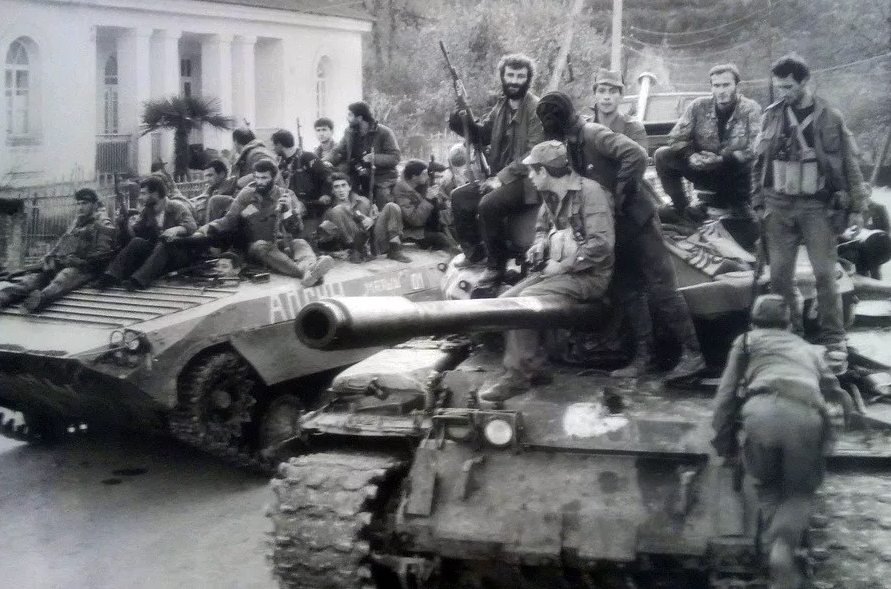"Shevardnadze Would Call Me at Home"

Eduard Shevardnadze, former Soviet foreign minister and then president of Georgia.
Vitaly Sharia / Ekho Kavkaza — A quarter of a century ago, on May 26, 1998, coinciding with the 80th anniversary of Georgia's Independence, Georgian armed forces planned an operation to seize control of the Gal district in Abkhazia. However, the execution of this operation deviated dramatically from their initial plan, resulting in the district being deserted for an extended period, marking the second time this occurred since the fall of 1993.
In the spring of 1998, there was a notable uptick in activity from Georgian revanchist groups – factions seeking to reclaim lost territory – within Abkhaz society. Most prominent among these were the militarised groups operating within the Gal district, specifically the "White Legion" founded in 1996 and later supplemented by the "Forest Brothers". The name "Forest Brothers" seemingly draws parallels to the Baltic anti-Soviet partisans who operated after World War II.
The "White Legion", the most significant of these "partisan" groups, had received training in camps located on Georgian soil. This group was led by Zurab Samushia, a follower of the former Georgian president, Zviad Gamsakhurdia. The "Forest Brothers" squad was under the command of Dato Shengelia, a former member of the "Mkhedrioni".

Boris Yeltsin (left), Eduard Shevardnadze, and Jaba Ioseliani, the founder of the Mkhedrioni paramilitary organisation, after signing the Treaty of Russian-Georgian Friendship, Good Neighborliness, and Cooperation on February 3, 1994.
This is how the first president of the Republic of Abkhazia, Vladislav Ardzinba, recalls those events in his book "My Life". The Republic's Ministry of Internal Affairs and State Security Service corroborated his observations, acknowledging the increased activity of "partisan band groups", in addition to the special forces of Georgia's Ministry of State Security and Internal Affairs within the district. These factions used several villages in the Gal district as their operating bases.
Ardzinba recollects: "On May 6, the Catholicos of Georgia, Ilia II, arrived in Zugdidi, accompanied by the leadership of the so-called Autonomous Republic of Abkhazia in exile, ostensibly to 'lift the spirits and consecrate' the combatants. Military movements from Georgia to Abkhazia were detected near the Russian peacekeeping post. Our operational intelligence suggested that the post's commander, Captain Kalin, was in league with a colonel from the 'White Legion'. The ultimate objective of the plan was to wrest control of the Gal district of Abkhazia and reinstate the 'legitimate authorities'. According to our sources, this military action was scheduled to coincide with May 26 - Georgia's Independence Day. Regrettably, our warnings were either ignored or dismissed. On the night of May 19, at the first signal, our reservists rose as one and made their way to the Gal district. During the six-day war, we achieved victory with minimal losses. Throughout the operation, we lost eight soldiers. Our enemy suffered over 100 fatalities, with an undisclosed number of injured. In the final days, even Shevardnadze called me personally, his primary objective being the extraction of his troops from Abkhazia by any means, to prevent their total annihilation. Our forces were so resolute that they even crossed over to the Georgian side of the Ingur river, ready to put up a staunch defence on enemy soil."
According to other sources, on May 26, the Georgian forces intended to seize the Gal district centre and establish the government of the Autonomous Republic of Abkhazia, led by Tamaz Nadareishvili. Reports from Georgian media indicated that the Abkhaz forces, numbering around 1,500 and equipped with T-55 and T-72 tanks, armoured personnel carriers, and artillery, preemptively entered the Gal district on May 20. Georgian fighters, armed with grenade launchers and firearms, held their positions at pre-arranged defences, with the active support of Georgian Ministry of Internal Affairs artillery and armoured vehicles. The most intense battles took place in the settlements of Khumushkur, Upper Bargyap, Sida, and Saberio (a village that houses the Ingur Hydroelectric Power Station dispatcher's office). The operation was led by the Deputy Minister of Defense, Colonel Vladimir Anua, who was the commander of the Eastern troop group and is now the Minister of Defense of the Republic of Abkhazia.

The offensive by the Abkhaz forces persisted across multiple directions on May 22. By May 24, a distinct frontline had formed along the railway station at Salhino, extending to Taglan-1, Sida, Upper Bargyap, and the settlement of Sabutbayo. As the Abkhaz forces initiated a large-scale operation, the Georgian command urged President Eduard Shevardnadze to deploy armoured vehicles in the Gal district and commence a full-scale war against Abkhazia. However, both the President and Georgia's Foreign Minister declined to do so.
A ceasefire protocol was signed at the state dacha in Gagra on May 26. According to Vladislav Ardzinba, as mentioned in his book, the arriving Georgian delegation, led by Foreign Minister V. Lordkipanidze, appeared visibly beaten. As per this protocol, the Georgian side was obligated to withdraw all its armed formations from the Gal district between 9 am and 1 pm that day. Intriguingly, the book highlights that the retreating forces left behind ammunition originating from Ukraine. The process of repatriating refugees, who had vacated their homes during the May skirmishes, commenced on March 1, 1999.
Today, the "Echo of the Caucasus" managed to get in touch with Lieutenant General Aslan Kobakhia, a recognised Hero of Abkhazia. He vividly recalls those events:

Aslan Kobakhia
"This was such an onslaught on Abkhazia, the likes of which we hadn't seen since September 30, 1993. Yes, there were skirmishes before, but never such a large-scale offensive. They managed to seize nearly two-thirds of the Gal district's territory. The Armed Forces of Abkhazia once again taught them a harsh lesson - occupation forces have no place on Abkhazian soil. It's noteworthy that this didn't occur abruptly but was preceded by five years of terrorist attacks on Abkhazia. These were perpetrated by reconnaissance groups that orchestrated raids, assassinated law enforcement officers, and targeted civilians. This situation represented a serious attempt to overrun an entire border district, Gal, leading to such high tensions that the Supreme Commander-in-Chief was compelled to call for a partial mobilisation."
Kobakhia goes on to add that despite these events, terrorist raids continued, albeit at a reduced intensity:
"Until 2008, more than 400 law enforcement officers lost their lives in the Gal district. This is not even accounting for civilian casualties and similar incidents."
This article was published by Ekho Kavkaza and is translated from Russian.